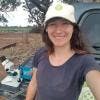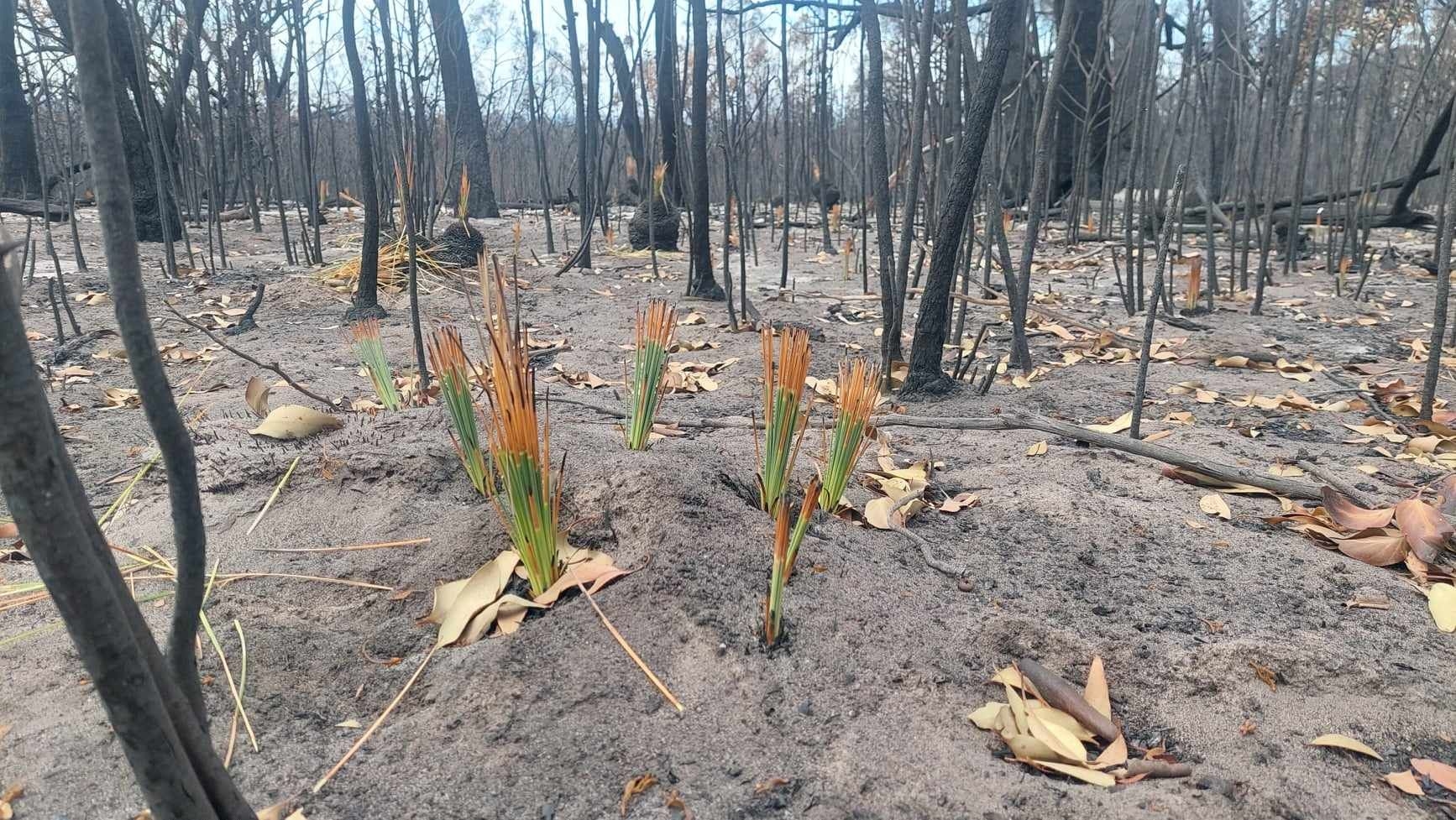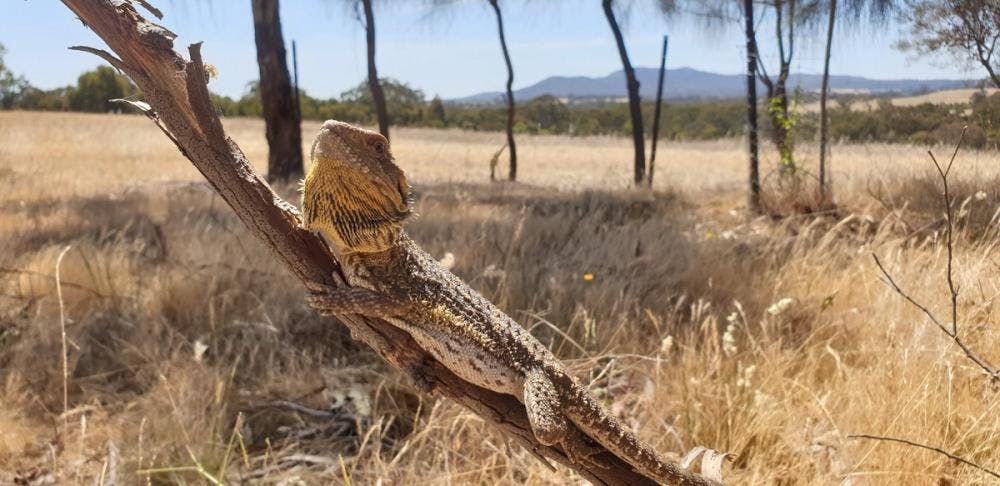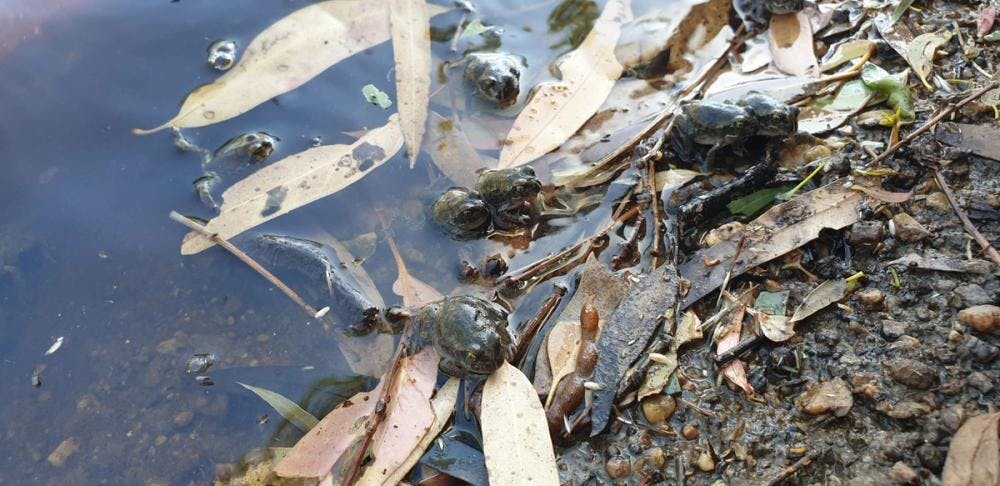21 March 2024
In the wake of bushfires, our caring and tight knit communities are very quick to seek to support recovery efforts, including for the area's affected wildlife. We want to help those ‘helpers’ be the most effective with their time. For that, we need to understand what a natural fire recovery looks like in our highly fire-adapted landscape, and where this natural recovery can get off track. Those are the places where humans can provide the best help.
What is the natural course of habitat recovery after a fire?
In the diverse landscapes of Australia, fire plays a complex role in shaping ecosystems. This is certainly true in our home region, under the view of the Gariwerd ranges. Naturally occurring bushfires, driven by the country's unique climate and vegetation types, have been a necessary part of its ecological dynamics for millennia. Many of Australia's native plant species and wildlife have evolved alongside fire, developing various adaptations to survive and thrive in the aftermath of bushfires.
Because the Grampians is no stranger to fire, there have been several scientific studies conducted that give us some insight into what we can expect to see, as the Pomonal, Dadswell and Mt Cole regions recover. There are several stages a forest goes through during regrowth after a fire: depending on habitat type these include renewal stage, juvenile stage, maturity and senescence (and more stages in between if you are getting detailed, see source 1). We will keep it simple and go through these main four stages, what the landscape looks like and where fire recovery can get off track.
Renewal Stage (0 to 0.5 years)
What will you see?
The landscape will look barren and black, but this does not mean all is dead (the grass trees had several inches of new growth within 2 weeks of the fire and already new growth can be seen on trees in the Pomonal area). Fire sensitive plants such as Hakea and Banksia will be killed (see source 2), and areas may be left devoid of any canopy or ground shelter.
You may see more animal activity than you are used to, due to the loss of covering habitat. You are seeing the surviving population now. This population is expected to decline, even as part of a natural fire recovery without additional stressors. Evidence from Grampians suggests there may be considerable mammal survival within burnt areas, particular arboreal species that can persist in small population sizes, such as antechinus. Their recolonization happens within the burn sites, rather than relying solely on migration. Habitat features that are able to withstand fire, such as logs, rocks and large trees, and unburnt patches where vegetation is still green are vital for these survivors (see source 3).
What can go wrong?
Invasive species
Surviving animals are at high risk of invasive species. Introduced predators, such as feral cats and foxes, exploit the reduced cover and increased visibility of prey in burnt landscapes, leading to higher predation rates on native species struggling to survive in the already challenging conditions. This impacts can be at its highest in the weeks post-fire (see source 4).
Drought
Climate can add a considerable stress on surviving species in the days and weeks after a fire, when food and water are hardest to come by. Research in the Grampians after 2006 fires showed that rainfall after fire events was strongly linked to larger populations for all native mammal species studied, while drought after fires can limit recovery significantly (see source 5).
The Juvenile Stage (0.5 to about 2.5 years)
What will you see?
The first plants to return will be a high density of “fire ephemeral” plants. These are short lived plants that germinate after fire and only live 1 to 10 years. These plants are vital to fire recovery. They cover bare soils to prevent erosion and run off. They provide food and shelter to animals. They even encourage the next phase of plants and fungi to grow, by creating more suitable conditions for this species to sprout and begin their recovery.
'Fire-tolerant' species will be able to resprout from below ground material. Trees devoid of leaves can still return with 'epicormic blooms' which sprout right off the trunk. A multitude of seeds in the seed bed will sprout. You may see species sprouting in burnt areas you have never seen before! These seeds have been waiting for years, even decades, for this chance to grow, uninhibited by canopy. They are built just for this – colonizing after a fire (see source 6).
It is difficult to predict how bird populations will react in the first couple years after fire. Studies recording diversity and abundance in the first few years post fire in eucalypt woodlands of Australia have yielded quite mixed results. Based on a 2006 fire study in the Grampains National Park, we may expect bird diversity to remain low for 3+ years post fire, and be highest where there is a mosaic of burnt/unburnt. Bird populations may experience a greater negative effect from high intensity fires, as according to data collected in the Grampians, fires classed as ‘wildfires’ rather than prescribed fires show a much more negative impact, with prescribed fires sometimes showing no decline in bird populations at all (see source 7).
One of the most poorly studies classes when it comes to fire recovery is invertebrates – yet they are the backbone of our ecosystems. A study after the 2006 Grampians fires on aquatic invertebrates yielded some good news – stream communities were already comparable in burnt and unburnt creeks 2 to 3 years post fire (see source 8).
What can go wrong?
Invasive species continue to be a major threat. Scientific data shows invasives like the house mouse are the first mammals to recolonise the area. Rocks and logs can become a double edged sword as they can also encourage black rats populations (see source 5). Good control of invasive predators like cats and foxes, and invasive herbivores like deer, are paramount during this time.
How can we help in the renewal and juvenile stages?
One of the ways we feel drawn to help is putting out food and/or water for the wild animals that now find themselves in a seemingly barren landscape. This is referred to as "supplementary feeding." While well-intentioned, this can sometimes have unintended consequences. Drought was the primary reason why the NSW state government made an exception to usual practice and condoned supplementary wildlife feeding after 2019/2020 fires. This intervention that is generally not advised for the public to engage in due to the outweighing risks to native wildlife.
The following posts contain more information on supplementary feeding and watering.
The most important area we can help, however, is in the control of exotic species.
The presence of introduced predators, such as feral cats and foxes, poses a heightened risk to native wildlife in post-fire environments. These predators often exploit the reduced cover and increased visibility of prey in burnt landscapes, leading to higher predation rates on native species struggling to survive in the already challenging conditions.
Considerable research has been conducted after the Black Saturday and Black Summer fires, regarding what habitat and wildlife interventions had the greatest positive impact. The consistent story that comes out of this research is that controlling introduced herbivores and predators is generally the most valuable intervention for supporting native species (see sources 9, 10 and 11). This is especially helpful for native mammals and reptiles, both groups having high proportions of ground-dwelling species that rely on vegetation cover for resources and to avoid predation (see source 9).
This figure on the left, from a review paper after the black summer fires, shows how the control of exotic predators and herbivores is the most valuable action for the majority of native animal species they studied. You can see that by the size of the green circles in the third and fourth columns (representing control of exotic predators and herbivores) being significantly larger than the circles within the columns representing supplementary nests, food and water (the second column). (see source 9)
Coming soon is more information on how we can each contribute to the control of invasive species around bushfire affected areas.
You may also be wondering if nest boxes can be helpful? Right now good invasive species control is the top priority, but as the mammal species that rely on tree hollows begin to move back into the burnt areas, nest boxes can be a useful way to support them. This may be particularly true for gliding species, which show good use of nest boxes in scientific studies. We are also currently working on pulling together information to help us create and deploy nest boxes in the most ecologically helpful way, so stay tuned...
We can focus our efforts at the moment on activities that are most helpful in the renewal and juvenile stages. But for reference, continued below are summaries of what to expect in the subsequent fire renewal stages.
The Adolescent Phase: About years 2.5 to 10
For the first several years, the forest may look very different than what you are used to, and may look denser and more impenetrable. But this is an important stage, and as it matures, will slowly begin to look more like that you were familiar with pre-fire. Good rainfall in this phase is key to good recovery
Mammal populations are likely to still be low, having declined from the ‘survivor’ populations due to limited resources. This is sad but natural. Most native mammals won't be expected to show population recoveries for nearly 10 years (see source 5). Population densities of ‘early coloniser’ mammals will increase first, due to enhanced food resources post-fire, such as green shoots. Unaffected retreat sites are key for mammal recovery, such as drainage lines and gullies for bush rats and antechinus. Large trees that survived are key for hollow nesting mammals like gliders and antechinius. More fire tolerant species like heath mouse are beginning to peak (see source 5).
Maturity: 10 – 20/30 years
This is when we see the second generation maturing of those plants that were killed by fire, but were triggered to produce seed as a final act, such as Banksias and Hakeas. At this point the slow responding mammals are showing signs of recovery.
Species like swamp rat, which do not survive well in brunt areas were likely to be locally extirpated after a fire. At this stage, colonists are starting to slowly move back into the area, to reestablish populations.
Senescence: 20/30+ years
At this stage, mammal populations are fully recovered. Species like agile antechinus, swamp rats, and bandicoots are some of the slowest to recover, not reaching high levels until 20 years after fire. Some populations of mammals are already declining, such as the heath mouse, as they prefer the Juvenile phase habitat.
At this stage, fire is beginning to be needed again. Without it, there is a risk of the fire ephemerals and fire obligate seeders being lost from the environment.
Sources:
1. Cheal, David C. Growth stages and tolerable fire intervals for Victoria's native vegetation data sets. Melbourne, Victoria, Australia: Victorian Government Department of Sustainability and Environment, 2010.
2. O’Donnell, Shawn A. "The ecological role of fire in the northern Grampians National Park: Management of serotinous species." 2007.
3. Hale, Susannah, et al. "Evidence that post‐fire recovery of small mammals occurs primarily via in situ survival." Diversity and Distributions 28.3 (2022): 404-416.
4. Leahy, Lily, et al. "Amplified predation after fire suppresses rodent populations in Australia’s tropical savannas." Wildlife Research 42.8 (2016): 705-716.
5. Hale, Susannah, et al. "Fire and climatic extremes shape mammal distributions in a fire‐prone landscape." Diversity and Distributions 22.11 (2016): 1127-1138.
6. Duncan, Mike. Response of Orchides to Bushfire: Black Saturday Victoria 2009: Natural Values Fire Recovery Program. Heidelberg, Victoria, Australia: Department of Sustainability and Environment, 2012.
7. Kerr, Gregory D., and Grant A. Gully. "Bird communities and effects of management in Heathy Woodlands in the Grampians/Gariwerd National Park." Transactions of the Royal Society of South Australia 147.2 (2023): 230-267.
8. Robson, B. J., et al. "Post-wildfire recovery of invertebrate diversity in drought-affected headwater streams." Aquatic Sciences 80 (2018): 1-15.
9. Legge, Sarah, et al. "Rapid assessment of the biodiversity impacts of the 2019–2020 Australian megafires to guide urgent management intervention and recovery and lessons for other regions." Diversity and Distributions 28.3 (2022): 571-591.
10. Geary, William L., et al. "Responding to the biodiversity impacts of a megafire: A case study from south‐eastern Australia’s Black Summer." Diversity and Distributions 28.3 (2022): 463-478.

Elia Pirtle
Landcare Facilitator and Communications Officer


